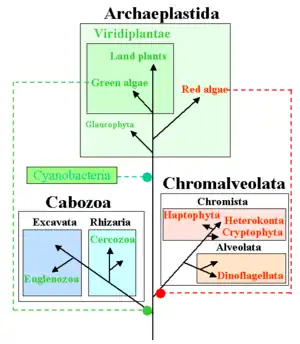Cabozoa
In the classification of eukaryotes (living organisms with a cell nucleus), Cabozoa was a taxon proposed by Cavalier-Smith.[1] It was a putative clade comprising the Rhizaria and Excavata. More recent research places the Rhizaria with the Alveolata and Stramenopiles instead of the Excavata, however, so the "Cabozoa" is polyphyletic.[2][3]

Evolution of the algae, as depicted by Thomas Cavalier-Smith in 2002. Neither the tree's structure nor some of the terms in the diagram reflect a modern consensus.
See also
References
- Cavalier-Smith T (1999). "Principles of protein and lipid targeting in secondary symbiogenesis: euglenoid, dinoflagellate, and sporozoan plastid origins and the eukaryote family tree". J. Eukaryot. Microbiol. 46 (4): 347–66. doi:10.1111/j.1550-7408.1999.tb04614.x. PMID 18092388. S2CID 22759799.
- Burki F, Shalchian-Tabrizi K, Minge M, Skjæveland Å, Nikolaev SI, et al. (2007). Butler G (ed.). "Phylogenomics Reshuffles the Eukaryotic Supergroups". PLOS ONE. 2 (8: e790): e790. Bibcode:2007PLoSO...2..790B. doi:10.1371/journal.pone.0000790. PMC 1949142. PMID 17726520.
- Zicha, Ondrej. "BioLib: Biological library". www.biolib.cz. Retrieved 17 March 2023.
This article is issued from Wikipedia. The text is licensed under Creative Commons - Attribution - Sharealike. Additional terms may apply for the media files.